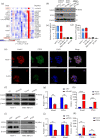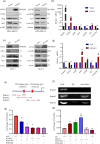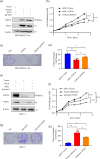Notch3 inhibits cell proliferation and tumorigenesis and predicts better prognosis in breast cancer through transactivating PTEN
- PMID: 34006834
- PMCID: PMC8131382
- DOI: 10.1038/s41419-021-03735-3
Notch3 inhibits cell proliferation and tumorigenesis and predicts better prognosis in breast cancer through transactivating PTEN
Abstract
Notch receptors (Notch1-4) play critical roles in tumorigenesis and metastasis of malignant tumors, including breast cancer. Although abnormal Notch activation is related to various tumors, the importance of single receptors and their mechanism of activation in distinct breast cancer subtypes are still unclear. Previous studies by our group demonstrated that Notch3 may inhibit the emergence and progression of breast cancer. PTEN is a potent tumor suppressor, and its loss of function is sufficient to promote the occurrence and progression of tumors. Intriguingly, numerous studies have revealed that Notch1 is involved in the regulation of PTEN through its binding to CBF-1, a Notch transcription factor, and the PTEN promoter. In this study, we found that Notch3 and PTEN levels correlated with the luminal phenotype in breast cancer cell lines. Furthermore, we demonstrated that Notch3 transactivated PTEN by binding CSL-binding elements in the PTEN promoter and, at least in part, inhibiting the PTEN downstream AKT-mTOR pathway. Notably, Notch3 knockdown downregulated PTEN and promoted cell proliferation and tumorigenesis. In contrast, overexpression of the Notch3 intracellular domain upregulated PTEN and inhibited cell proliferation and tumorigenesis in vitro and in vivo. Moreover, inhibition or overexpression of PTEN partially reversed the promotion or inhibition of cell proliferation induced by Notch3 alterations. In general, Notch3 expression positively correlated with elevated expression of PTEN, ER, lower Ki-67 index, and incidence of involved node status and predicted better recurrence-free survival in breast cancer patients. Therefore, our findings demonstrate that Notch3 inhibits breast cancer proliferation and suppresses tumorigenesis by transactivating PTEN expression.
Conflict of interest statement
The authors declare no competing interests.
Figures







Similar articles
-
Notch3 Maintains Luminal Phenotype and Suppresses Tumorigenesis and Metastasis of Breast Cancer via Trans-Activating Estrogen Receptor-α.Theranostics. 2017 Sep 20;7(16):4041-4056. doi: 10.7150/thno.19989. eCollection 2017. Theranostics. 2017. PMID: 29109797 Free PMC article.
-
NOTCH3 signaling pathway plays crucial roles in the proliferation of ErbB2-negative human breast cancer cells.Cancer Res. 2008 Mar 15;68(6):1881-8. doi: 10.1158/0008-5472.CAN-07-1597. Cancer Res. 2008. PMID: 18339869
-
The LXR-623-induced long non-coding RNA LINC01125 suppresses the proliferation of breast cancer cells via PTEN/AKT/p53 signaling pathway.Cell Death Dis. 2019 Mar 13;10(3):248. doi: 10.1038/s41419-019-1440-5. Cell Death Dis. 2019. PMID: 30867411 Free PMC article.
-
PIM-induced phosphorylation of Notch3 promotes breast cancer tumorigenicity in a CSL-independent fashion.J Biol Chem. 2021 Jan-Jun;296:100593. doi: 10.1016/j.jbc.2021.100593. Epub 2021 Mar 26. J Biol Chem. 2021. PMID: 33775697 Free PMC article.
-
The Role of Notch3 in Cancer.Oncologist. 2018 Aug;23(8):900-911. doi: 10.1634/theoncologist.2017-0677. Epub 2018 Apr 5. Oncologist. 2018. PMID: 29622701 Free PMC article. Review.
Cited by
-
NRF2 signaling plays an essential role in cancer progression through the NRF2-GPX2-NOTCH3 axis in head and neck squamous cell carcinoma.Oncogenesis. 2024 Sep 27;13(1):35. doi: 10.1038/s41389-024-00536-z. Oncogenesis. 2024. PMID: 39333079 Free PMC article.
-
Identification of senescence-related subtypes, establishment of a prognosis model, and characterization of a tumor microenvironment infiltration in breast cancer.Front Immunol. 2022 Aug 22;13:921182. doi: 10.3389/fimmu.2022.921182. eCollection 2022. Front Immunol. 2022. PMID: 36072578 Free PMC article.
-
A Transcriptomic Analysis of Laryngeal Dysplasia.Int J Mol Sci. 2024 Sep 7;25(17):9685. doi: 10.3390/ijms25179685. Int J Mol Sci. 2024. PMID: 39273632 Free PMC article. Review.
-
Berberine governs NOTCH3/AKT signaling to enrich lung-resident memory T cells during tuberculosis.PLoS Pathog. 2023 Mar 7;19(3):e1011165. doi: 10.1371/journal.ppat.1011165. eCollection 2023 Mar. PLoS Pathog. 2023. PMID: 36881595 Free PMC article.
-
Long noncoding RNA SNHG15: A promising target in human cancers.Front Oncol. 2023 Mar 28;13:1108564. doi: 10.3389/fonc.2023.1108564. eCollection 2023. Front Oncol. 2023. PMID: 37056344 Free PMC article. Review.
References
Publication types
MeSH terms
Substances
LinkOut - more resources
Full Text Sources
Other Literature Sources
Medical
Research Materials
Miscellaneous

